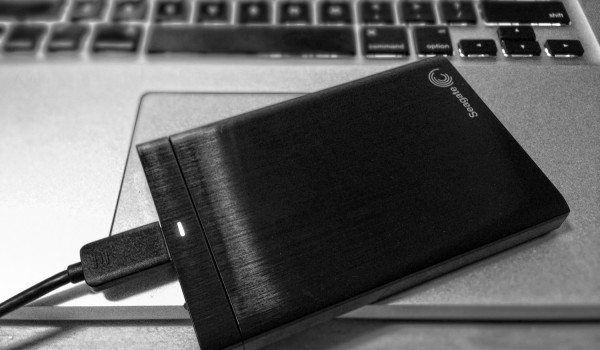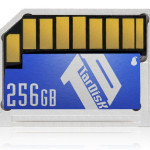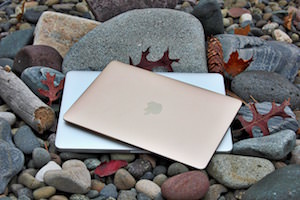
Because Apple is so stingy with storage — you get just 128GB in the entry-level MacBook Air and MacBook Pro — having a good external hard drive for Macs is important for offloading your large video and photo files. Better yet, a good external drive will let you create a full system backup copy of your drive. With dozens of external drive options, how do you find a good external hard drive for Mac?
The hard drive answer starts with two key connectivity options: USB 3.0 and Thunderbolt.
USB 3.0 is a widely-used standard that will let you plug your hard drive into most any Mac or PC with a USB port. USB 3.0 is much faster than USB 2.0 (so avoid USB 2.0 drives).
Thunderbolt is a newer connectivity standard for all Macs, and it’s useful for connecting different kinds of peripherals, including displays — even in a daisy chained way. For professional use, you can get excellent flexibility and speed, but for most people, in most situations, USB 3.0 will work great.
Best External Hard Drive for Macs: Go Portable
Next, I prefer to choose portable external hard drives over desktop versions because they are just so much easier to pack. In addition, I very much prefer bus-powered drives, that is, drives that will run off power from your USB 3.0 port or Thunderbolt port connections. That way you don’t need an external power cord to worry about.
Solid State vs Hard Disk Drives
Solid State Drives (SSD) are much faster than spinning Hard Disk Drives (HDD). SSD drives are usually more durable, too — but SSDs are much more expensive. For example, a 256GB SSD drive might cost close to $300 while a 1TB HDD drive can offer four times as much storage capacity for only $69.
So why choose an SSD external drive? 1) You have the money, and 2) you plan to work with large video and photo files directly from your external drive. (For most people, though, the sheer value of an HDD drive usually wins out.)
Formatting Notes
To get the best performance out of an external drive for a Mac, you’ll want it to be formatted in the Apple HFS+ format, a.k.a. “Mac OS Extended, Journaled.” When you buy, look for HFS+ . . . and you’ll be good to go — just plug it in and start transferring files or backups. If you get a drive that is, say, formatted in FAT32, you can use it with your Mac but you might experience problems with iPhoto or Aperture photo files sometime down the road. If you’re totally Mac-focused, don’t mess with FAT32 and just use Disk Utility on your Mac to reformat the external drive before you use it (and then download an HFS+ driver for your Windows machine if you need to access the drive from Windows). But, you probably bought a Mac because it’s so easy, so just look for HFS+ from the start and save yourself the headache.
Here’s Some Excellent External Hard Drive Options:
Seagate Backup Plus Slim 1TB Portable External Hard Drive for Mac — This USB 3.0 drive is super slim, portable, and you can usually get 1TB of storage at a compelling price point.
WD My Passport for Mac 2TB Portable External Hard Drive — This USB 3.0 drive is portable and available in options up to 2TB of storage.
Seagate Backup Plus 4TB Desktop External Hard Drive for Mac — This whopping 4TB drive is not portable, comes with a separate power cord, but hey, it’s loaded with 4TB of space.
LaCie Porsche Design Slim 120GB SSD Drive — You get 120GB, but it’s super-fast SSD gigabytes. Ships unformatted, so you’ll have to format it first.
LaCie Rugged USB 3.0 Thunderbolt Series 256GB Solid State Drive — Both USB 3.0 and Thunderbolt and 256GB of fast SSD speed, all in a portable, rugged enclosure.
Consider the Ease of a USB Flash Drive Instead:
The new USB 3.0 “thumb” drives based on solid state flash storage have grown in capacity while prices have fallen — so much so that they offer a rival option to larger SSD external drives. Plus, their sheer portability should be enough to make any MacBook owner take a closer look.
Check out these two models, both of which are available up to a whopping 256GB.
- Patriot 256GB Supersonic Boost Series USB 3.0 Flash Drive
- Corsair Flash Survivor Stealth 256GB USB 3.0 Flash Drive
What About Using Your SDXC Card Slot for More Mac Storage?
If you want more on-board, nearly built-in storage, you have two cool options, both of which are tiny flash-based drives in the shape of camera memory cards. They plug into the SDXC card slot on your MacBook Air or MacBook Pro.

The TarDisk Pear system is a tiny drive that you can combine with your built-in drive to create a single “fused” storage system on your MacBook Air or Pro.
For all intents and purposes, the Transcend JetDrive Lite acts like a little USB thumb drive — but it fits flush into the SDXC card slot instead and appears on your Mac like an external drive that is always on, always available. It appears as a separate storage option to your Mac’s operating system. Quite handy.
The TarDisk Pear system, on the other hand, also uses the SDXC card slot but it combines with your built-in storage to form a single “fused” drive. If you want a near-permanent — but easy storage solution for your MacBook Air or Pro, the TarDisk Pear system might be your best bet.
Of course, if you use your SDXC card slot for loading photos, you can pick up a small USB-based card reader like the Kingston Digital MobileLite G4 Card Reader to easily load photos and video off of your SD camera cards through a USB port.








